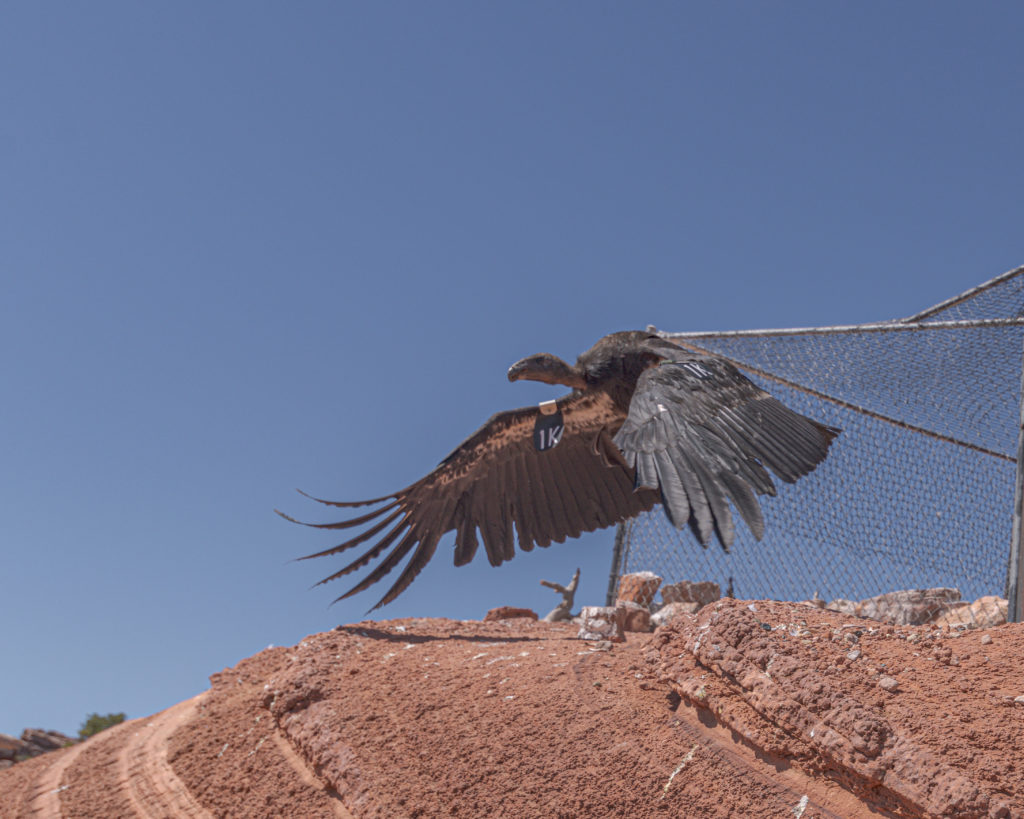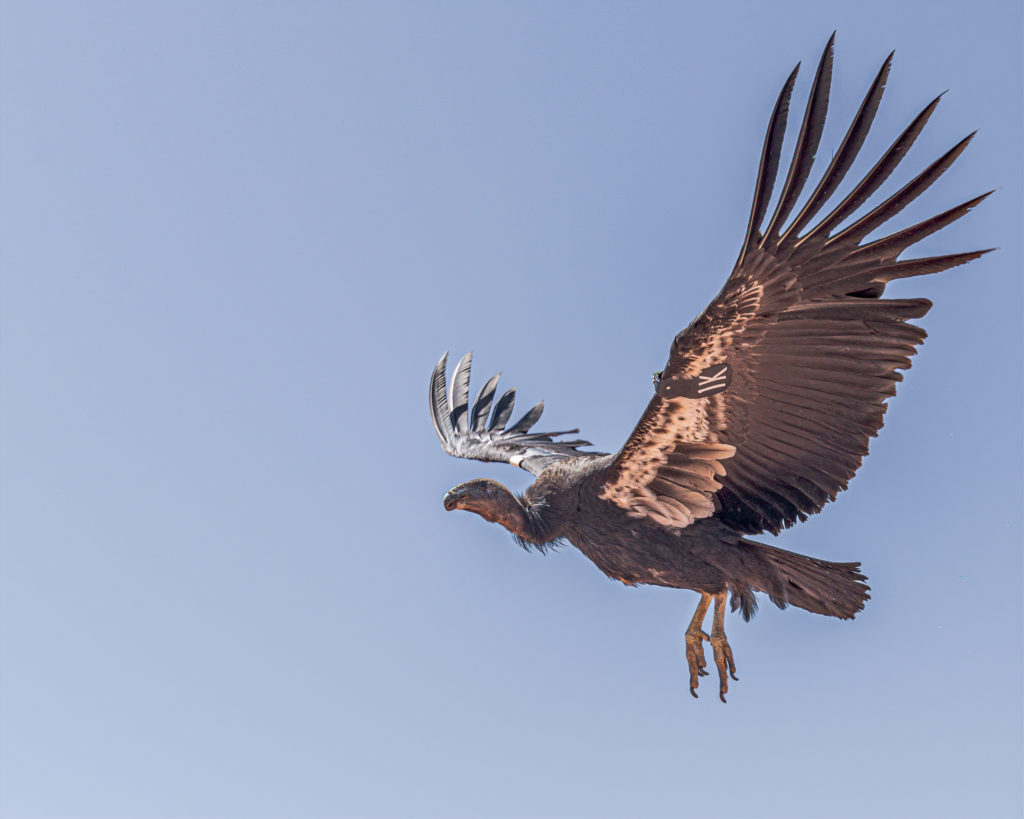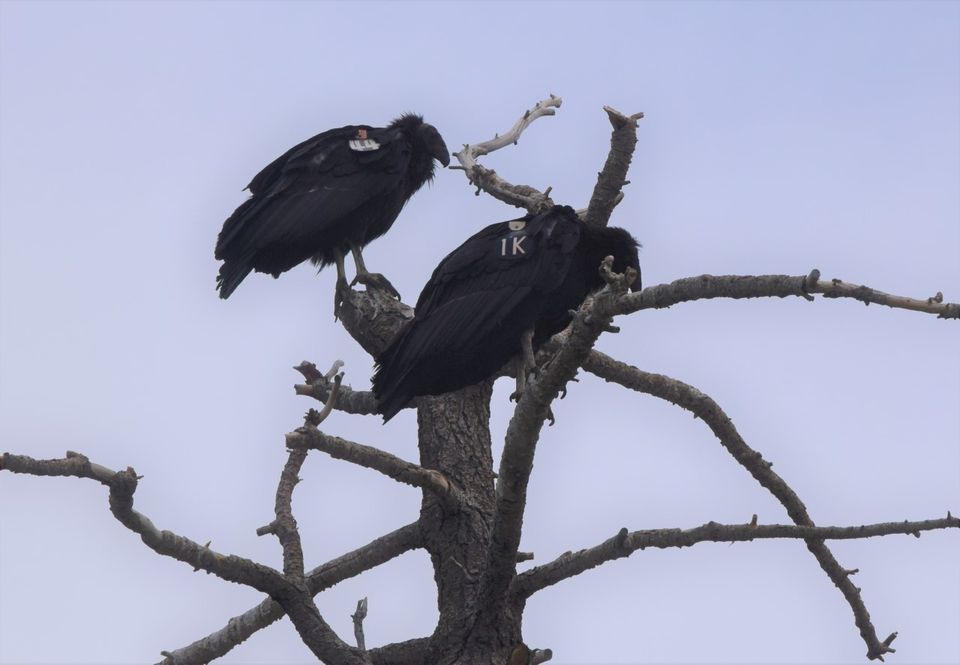ST. GEORGE — The California condor chick in Zion National Park, which park biologists estimated to have hatched May 9, 2019, has been confirmed to be a male.

In a post on the park’s Facebook page, it said that blood test results on the California condor, nicknamed “1K,” determined that it was a boy.
California condors – scientific name Gymnogyps californianus – have an average lifespan of 60 years in the wild.
According to the park post, condor 1K’s age as compared to a human’s is about that of a young adult preparing to leave for college or home for good.
Condors only produce one egg at a time and the parents spend over a year with the young bird preparing it to become independent, the post said.
As late fall, early winter arrives, condor 1K’s parents, breeding pair 409, female, and 523, male, will slowly start to push their son away, giving them more opportunity to think about breeding again.
Tim Hauck, Condor Program Manager at the Peregrine Fund, one of the main private partners of the condor recovery program, said condor 1K will not reach breeding age until around 5 years old.
So why is knowing the bird’s sex important?
In truth, Zion National Park Wildlife Program Manager Janice Stroud-Settles, said it’s actually not.

“At this point in time it really has no significance,” Stroud-Settles said of the young condor’s gender.
“It was more of a cool thing to know,” she said, adding that people like to anthropomorphize the birds.
That said, part of the conservation efforts for the critically endangered bird – there are close to only 350 of them in the wild – is monitoring the population’s gender ratio, particularly as they mature and reach breeding age, she said.
Because California condors are not sexually dimorphic, meaning there is no noticeable difference in size or appearance between genders, the only ways to determine the bird’s sex are to wait until it reaches breeding age and observe its breeding behavior or through a blood test, Hauck said.
According to a previous St. George News report, the Peregrine Fund, which manages day to day monitoring of the population, began breeding the carrion birds in captivity in Boise, Idaho in the 1990s.
The fund is part of the larger decades-long California Condor Recovery Program, a multiagency effort led by the U.S. Fish and Wildlife Service.
Founded in the 1970s, the Peregrine Fund began its raptor recovery efforts with the then endangered peregrine falcon, information from the nonprofit’s website said.
The falcon was removed from the United States Endangered Species list in 1999, leading the organization to expand its efforts to other birds of prey throughout the world, including the California condor.
Chris Parish, the Global Director of Conservation for the Peregrine Fund, said as the peregrine falcon was being delisted as an endangered species, the organization was approached to help breed and monitor the critically endangered condor.

“It’s a public trust, these birds, and we are just the ones lucky enough to get to work with them,” Parish said of their part in the recovery efforts.
The group also heads the condor release program. Birds in the Peregrine Fund’s recovery program go to release sites in Arizona, California and Baja Mexico.
California condors, like 1K and his parents, that have made their way to Zion National Park are part of release efforts that take place every September on National Public Lands Day at Vermillion Cliffs National Monument in Arizona, the same St. George News report said.
Condor 1K’s female condor parent was released at Vermillion Cliffs in 2008, and his male condor parent was released at Vermillion Cliffs in 2011.
Tracking the large raptors is another important aspect of species recovery efforts, Hauck said. While birds that are bred in captivity and released are easy to tag and track, birds like 1K that were born and fledged in the wild are less easy to track, he said.
Many of the captive-bred birds that are released eventually make their way back to the release site at Vermilion Cliffs, Hauck said, which is exactly what happened with condor 1K and its parents.
“Condor 1K came with its parents back to Vermilion Cliffs,” Hauck said. “That gave us our first clue that it was in fact 1K. Both parents were there with an untagged juvenile which tipped us off real quick.”

From there, Hauck said they were able to safely trap the bird and fit it with a tag and a transmitter, which will aid in monitoring 1K’s movements and health so that the fund can step in if necessary.
The bird was also vaccinated against West Nile virus and a blood draw was taken to confirm its genetics and determine its sex.
Having a transmitter on the bird, which is still spotted in Zion National Park 2-3 times a week, will go a long way toward aiding the park’s dedicated group of volunteers who help monitor the condor’s movements in and around the park, park volunteer coordinator Eleanor Seibers said.
The corps group of volunteers has spent nearly 2,500 hours tracking the birds and educating park guests about the endangered species and the important recovery efforts.
“The condor folks are especially dedicated,” Seibers said, adding that their efforts have helped to give the park a public face for the birds that park staff doesn’t have time to solely dedicate themselves to.
Volunteers routinely hike to Scout’s Lookout on the Angel’s Landing Trail where the birds are often spotted, both to listen to the telemetry equipment as well as to educate park visitors on the condors, Seibers said.
Stroud-Settles echoed Seibers on the importance of the volunteers, particularly in educating visitors.
“Not every human knows what a condor is or that they are endangered,” Stroud-Settles said, adding that the volunteers also make sure that the birds are behaving as wild birds and not becoming accustomed to humans.
“It is much easier to teach a bird than a human sometimes,” she said.
The more groups like the Peregrine Fund study and understand the California condor, the more they have come to know that the primary critical endangerment of the population is a human-caused problem, one that is largely preventable.

Lead poisoning from ammunition spent by hunters is often digested by the carrion birds as they scavenge carcasses for food. The Peregrine Fund has determined that over half of all condor deaths are due to lead poisoning, and in fact, condor 1K’s female parent’s first mate died of lead poisoning.
But, Parish said that studying condors has given researchers and conservationists a unique gift in that they were able to identify the threat and reach out to hunters to engage them in a unique effort to help bring back the bird population.
Hunters can help by switching to nonlead ammunition.
“The greatest gift they (the condors) gave us is synonymous with the gift of science. The more we came to know about condors the more we knew that this was a human-related problem,” Parish said. “What we’re doing with the science is engaging with hunters, it’s a different paradigm in conservation.”
Parish said that even though it is a human-caused problem, there are also real solutions and that there are good humans out there listening to the research, contributing to the work and making changes to help recover the species.
“That gives me hope,” Parish said. “Anything we can do to make our environment a better place just feels like good work.”
Hauck agreed.
“Trying to save a species that very nearly went extinct is very fulfilling. I feel very fulfilled,” he said. “I get to be out in the field and hang out with these birds with amazingly cool personalities and even bigger wingspans.”
The 25th annual condor release will take place Sept. 26 from 11 a.m. to 1 p.m. at Vermillion Cliffs National Monument in Arizona. Due to health concerns related to the COVID-19 pandemic, the release will be made viewable to the public virtually.
Click on photo to enlarge it, then use your left-right arrow keys to cycle through the gallery.
Condor 1K is released after being tagged at the Vermillion Cliffs, Arizona, date not specified | Photo by Alan Clampitt, St. George News Condor 1K perches on a cliff in Zion National Park, Utah, date not specified | Photo by Pete Gorzalski courtesy of the National Park Service, St. George News Condor 1K is spotted with another condor in Zion National Park, Utah, date not specified | Photo by Barry Rhodes courtesy of the National Park Service, St. George News Condor 1K perches on a cliff in Zion National Park, Utah, date not specified | Photo by Pete Gorzalski courtesy of the National Park Service, St. George News Condor 1K perches on a cliff in Zion National Park, Utah, date not specified | Photo by Pete Gorzalski courtesy of the National Park Service, St. George News Angela Woodside and Tim Hauck perform a blood draw on condor 1K at Vermillion Cliffs, Arizona, date not specified | Photo by Alan Clampitt, St. George News





Copyright St. George News, SaintGeorgeUtah.com LLC, 2020, all rights reserved.

